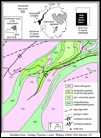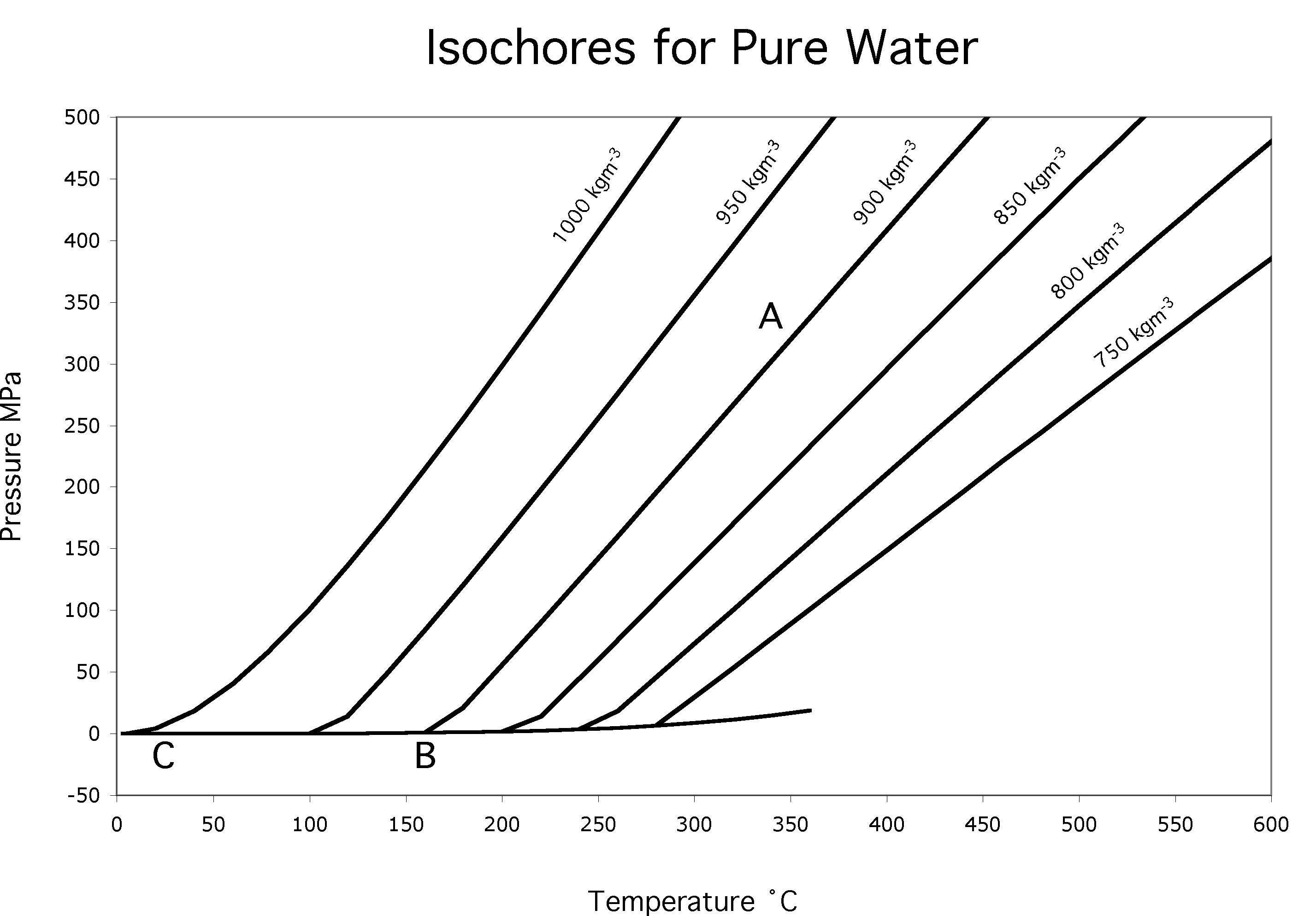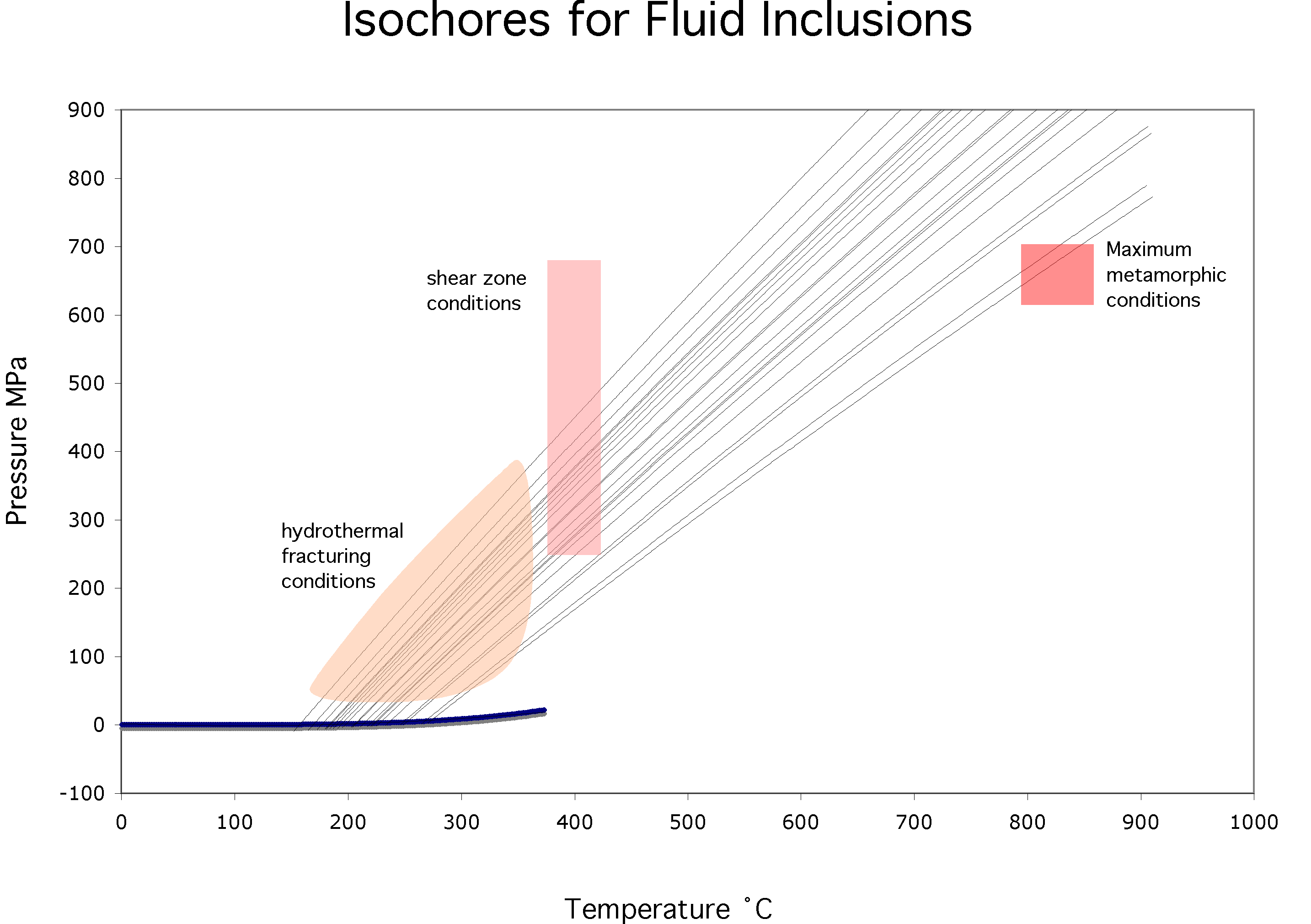Conditions of Microfracturing in the Southwestern
Adirondacks
by Fluid Inclusion Analysis
John-Luke Henriquez, Dr. Gayle Gleason, and Dr. Bob Darling
Geology Department, State University of New York College at Cortland, Cortland, NY
by Fluid Inclusion Analysis
John-Luke Henriquez, Dr. Gayle Gleason, and Dr. Bob Darling
Geology Department, State University of New York College at Cortland, Cortland, NY
Introduction
The purpose of this
study was to analyze fluid inclusions from a sample of mylonite rock from the
Adirondack Mountains to find the conditions at which late stage fracturing occurred and to determine the deformation
history of this small region of the Adirondacks.
The fluid inclusions cut across the
mylonite and are normal to its shear fabric, thus the
fluid inclusions represent the latest geologic event recorded in these
rocks. By measuring the minimum
trapping temperatures, the conditions during fracturing, the youngest event, can be constrained.
Fluid inclusions are pockets of gas and liquid that are
found inside crystals of various minerals, especially quartz. Primary fluid
inclusions form during the genesis or recrystallization
of the mineral. Secondary fluid inclusions form when fractures in a rock heal after a dissolved quartz-bearing hydrothermal
fluid runs through them and heals the fractures.
The fluid inclusions found in the mylonite are rock are secondary fluid
inclusions. After the rock fractured, the molecules were still in the orientation that they were before they
were fractured. When the hydrothermal quartz nucleated on the fracture, it
continued in the orientation that the quartz was in before it was fractured.
Thus, you cannot tell the difference
between the two stages of quartz growth by
merely looking at it; you must analyze it by looking at the fluid inclusions or
a scanning electron microscope.
Geologic Location
Samples came
from a location along the Moose River in the western Adirondack Mountains of
New York State (Fig. 1). Lithology
in this area is granitic gneiss, amphibolite and metasedimentary rock (unit CG of Whitney et al., 2002). Specifically, the mylonitic shear zone
is located within a pegmatitic dike that cuts across the
foliation of the surrounding granitic gneiss (Fig. 2).
According to Whitney et al. (2002), the igneous protolith of the gneiss may have been intruded 1160 Ma
to 1090 Ma, then deformed during a collisional event approximately 1050 Ma. They estimate that
deformation was over by about 1030 Ma, but temperatures
remained elevated resulting in undeformed pegmatite dikes (in the neighboring
Port Leyden Quadrangle). Zircon from one such dike produced a concordia
intercept date of 1034 +/- 10 Ma. The mylonitic shear zone described here clearly post dates the
crystallization of the pegmatite dike.
The fluid inclusions formed during an even later hydrofracturing event.
Interpretation
The conditions of hydrothermal microfracturing can be
constrained by the isochores corresponding to the minimum trapping temperatures
and by the conditions at which the shear
zone formed (Fig. 7). The hydrofracturing occurred after the shear zone
formed, as indicated by the observation
that the fluid inclusion trails cut across the quartz ribbons
in the shear zone. The temperature
range during the shear zone formation is estimated from the chemistry of the two feldspars recrystallized in the
shear zone matrix, and is consistent with
the quartz microstructures (Gleason and DeSisto, in review).
The lower pressure limit is estimated by assuming 250 MPa is required
for suppressing brittle failure during shear zone formation. The upper pressure limit is that of the maximum metamorphic conditions for the gneiss in
this part of the Adirondacks (Darling et al., 2004). As the rocks of the Adirondacks cooled and were uplifted to their current
elevation, they had to have passed through each of the shaded regions in Figure 7. This path
is a counter-clockwise pressure-temperature path consistent with Darling et al.
(2004), as well as with many other studies.


Results
Minimum trapping temperatures for these fluid inclusions
range from 152 to 270šC with an average of 210šC (Fig. 6). These results imply the hydrothermal fluids moving through the rock at the time
of hydrofracturing had an average minimum temperature of 210šC. To
place these data on the isochore plot, we
assumed the fluids were pure water (Fig.
7). We could not determine the salinity of the fluids because
the inclusions were too small to observe the
necessary crystal formation upon cooling. In addition, while these data provide a range of temperatures and pressure for
trapping, the pressure could not be constrained.
References:
€Darling,
R.S., Florence, F.P., Lester, G.W., and Whitney, P.R., 2004, Petrogenesis of
prismatine-bearing metapelitic gneisses along the Moose River, west-central Adirondacks,
New York, in Tollo, R.P., Corriveau, L., McLelland, J., and Bartholomew, M.J., eds.,
Proterozoic tectonic evolution of the Grenville orogen in North America: Boulder, Colorado,
Geological Society of America Memoir 197, 325-336. €Gleason, G.C., and DeSisto, S., in review, A natural example of crystal-plastic deformation
enhancing the incorporation of water into quartz. €Whitney, P.R., Fakundiny, R.H., and Isachsen, Y.W. 2002. Bedrock Geology of the Fulton
Chain-of-Lakes Area, west central Adirondack Mountains, New York. New York State
Museum Map and chart series no. 44, 124 pp.
Fig. 1 Map of study area showing location and geology.
Fig 2. Shear zone boundary within the pegmatitic dike.

The samples were placed on a
heating stage (Fig. 3), and the individual inclusions were located to determine their minimum trapping temperatures. The
samples were heated up until the gas bubble
trapped inside the inclusion disappeared. It is difficult to tell exactly when
the gas bubble disappears in many inclusions
because the trapped gas bubbles continuously
shrink as temperature goes up. This makes
telling when the bubble disappears difficult. To overcome this difficulty, each
sample was put through a cooling and heating cycle. Once the bubble was no longer
observed, the sampled was cooled.
If the bubble reappeared suddenly
after cooing of about 20šC, then the bubble
had been fully homogenized at the highest temperature experienced. If, on the other hand, the bubble reappeared after only a few
degrees of cooling and simply grew, then the
bubble had not been homogenized and the cycle was repeated. This cycling was continued until a precise minimum trapping temperature of the
fluid inclusion was determined.
Even with the cycling protocol, the
margin of error using this method is a few degrees.
Methods
Samples of mylonite
rock were cut perpendicular to the shear fabric of the mylonite, and parallel to the
planes of fluid inclusions; this would allow us to analysize several inclusions within the
hydrofracture. One side off each
sample was polished, then attached to glass slides using Crystalbond (which is
soluble in acetone).
The samples were trimmed using a rock saw. The cut side was then polished. After this, they were taken off the
glass side by dissolving the Crystalbond in
acetone and cut into sections that had prominent quartz bands in them. These
sections were put into boxes and labeled.
The sections were
looked at under a polarizing microscope (Fig. 3) to look for fluid inclusions along the same plane.
After they were found, they were photographed and
labeled, so that they could be found later (Fig. 4).

Isochore plot: The minimum trapping temperature corresponds to the
density of the fluid trapped in each
inclusion. The density of the
fluid within the inclusions is constant regardless of temperature, because the inclusions have a constant volume and mass
of water. The isochores (Fig.
5) represent the pressure and temperature for water of different
densities and thus different minimum trapping temperatures. The fluid must
have been trapped along an isochore line.
For example, a fracture may have formed when
the rock was at a confining pressure of 350
MPa and a temperature of 350šC (point A in Fig. 5). When the fracture healed, the fluid was
trapped. As the rock was cooled
and uplifted, the conditions within the
fluid inclusion followed the isochore to the boiling curve (point B). Thus, heating the inclusion from room temperature (point C) moves it to the right, along the boiling curve. As the
fluid warms, the bubble shrinks until it reaches it homogenization temperature
(point B), at which point the
bubble disappears. This is also the minimum trapping temperature (point B). It is a minimum
temperature because the homogenization may have actually occurred anywhere
along the isochore line.
Fig. 3 Heating
stage on petrographic microscope.
Fig. 6
Frequency plot of minimum trapping temperatures
Fig. 5
Pressure-Temperature plot showing isochores for pure water.


Fig.
4 Micrographs of A. quartz ribbon in the mylonite.
B. fluid inclusions from section indicated.
B. fluid inclusions from section indicated.
A.
B.

Fig.
7 Pressure-Temperature plot with isochores for the minimum
trapping temperatures of the fluid inclusions and conditions
of hydrofracturing.
trapping temperatures of the fluid inclusions and conditions
of hydrofracturing.
Fluid inclusions
with vapor bubble
with vapor bubble

Quartz ribbon
